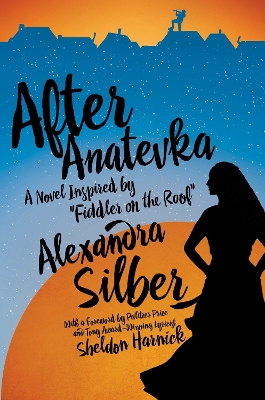Reviewed by Steph L on
Personal thoughts going in
I loved Fiddler On The Roof, my love for the show is large and it’s deep. I’ve loved it from the time that I was young. When I heard about this book I lit up, and I was so excited. I had heard of Alexandra before never seen her perform, but I knew of her. I got this book in November, and I was so excited to read it!!! Hodel is my favorite character and seeing that the book had her front and center it was exciting.
Characters
For pronunciation of these names go here: http://www.dialectsarchive.com/fiddler-on-the-roof
Hodel
Perchick
Tzeitel
Chava/Chavaleh
Shprintze
Bielke
Golde
Tevye
Motel Kamzoil
Plot
I really enjoyed the plot of this book. It was creative, and I really thought that it worked well for the characters that she was using. It was not like most sequels you read where all the characters are in the novel. The other characters are in the book in memories, and in flashback, but the main plot of the book followed out young lovers Hodel and Perchick. The weaving in and out between the memories and flashback, and joining the characters in their present day was very well done.
The book is broken into parts, and I thought that this was a great way to tell the story. Book one is told from the point of view of Hodel, and I think that this was a great way to start the book. Book 2 opens with Perchick and I felt like this helped the book progresses the plot in a unique way. This book started off as a way of easing you into what was going on at the time, both historically and in the lives of the characters in the story. The further you go into the book, the darker it gets for example in book two when you hear what Perhick has been doing it gets darker. When the book culminates in book 3, it is very dark and talks about some very real events that were going on at the time. I loved how the plot got darker as the book went on, and how it was interspersed with both happy times and dark times.
I don’t wish to spoil the end of this book, but I would like to tell you to read till the end of the book. Things happen, both good things and bad things and I think that you should push through till the end of this book.
Writing
The way that this book was written was very well done. Both the happy moments and the very sad moments were all written very well. I was taken on a journey with this book, and the way that this book was written was a big part of that. It was styled in a way that I loved, were you not only had chapters but you had three books that cohesively went together. I can just from reading this, that a lot of research went into this book and you can tell this in the writing. It is fiction, yes, but it is based on real things and real places that were around at the time, and the way that this is presented is a way that both progresses the story and also educates the reader on what was going on at that time.
Reading updates
- Started reading
- 10 February, 2018: Finished reading
- 10 February, 2018: Reviewed
